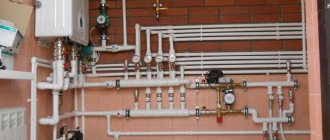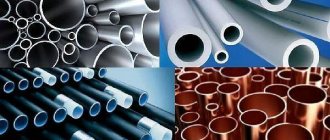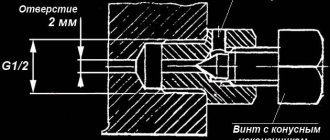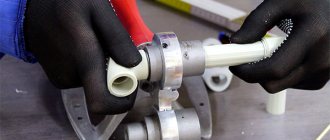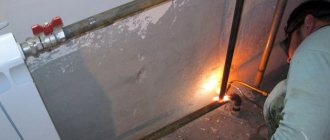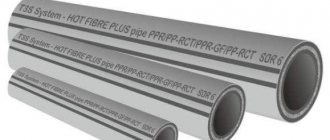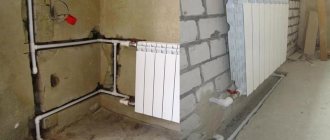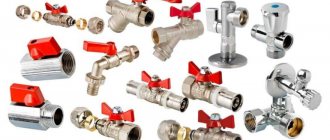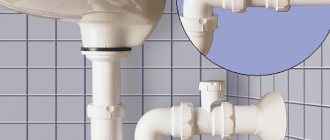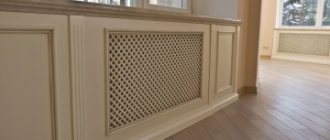Building a house or renovating an apartment involves installing a heating system and choosing materials suitable for this task. Which polypropylene is better for heating is one of the questions that arises during the search process among the wide variety of products on the market. To find the correct answer, you have to review large volumes of information materials, which sometimes contain conflicting data on available polypropylene products. Our article will greatly facilitate the selection process and help you set up a reliable and durable heating system.
A little theory to understand which polypropylene is better and why
In practice, it is better to use polypropylene pipes for heating systems. The advantage of this choice is due, first of all, to the lightness and reliability of the material, ease of installation, long service life and the wide range available on the market. Also, arguments in favor of using polypropylene include safety during operation when supplying hot water.
Pipes made from this material are an excellent alternative to cast iron heating products, which were previously used in plumbing and heating systems. They especially clearly showed their advantage in technical parameters, namely:
- Multilayer polypropylene pipe structure, which increases the wear resistance of the products several times, allowing them to be used in cold and hot water supply systems;
- Simple and quick heating installation;
- Convenient delivery of pipes to their destination due to the lightness of polypropylene;
- Easy to maintain;
- Polypropylene is better protected from fire;
- No painting required;
- High tightness of polypropylene;
- The material prevents the spread and reproduction of harmful microorganisms and the deposition of salts;
- Better withstands high levels of water pressure in heating systems;
- Protection against stray currents;
- Polypropylene is hygienic and harmless to health, since it does not emit toxic compounds when heated and does not affect the water structure;
- The best indicator of hydraulic resistance and absence of fluctuations during transportation of liquid through heating pipes;
- Resistance to aggressive chemicals and mechanical damage;
- Polypropylene better resists deformation even at high temperatures up to 120 degrees.
And this is not the entire list of advantages of this polymer over other materials for heating installation. It has a more favorable price, a higher quality guarantee and service life (up to 50 years) and other equally important indicators.
Polypropylene pipes are used in various fields of construction:
- Installations in the boiler room;
- Cold/hot water supply system;
- Installation of heated floors;
- Central heating system;
- Installation of risers;
- In agriculture for the purpose of drainage of waste and soil water, arrangement of drainage and irrigation systems;
- In industrial enterprises, polypropylene is used in systems for delivering compressed oxygen and chemical liquids;
- The best selection of polymer pipes from a wide range of manufacturers - Russia, Czech Republic, China, Italy, Turkey and other countries.
Installation steps
The installation process consists of several stages: preparation of the room and location for the boiler, its installation;
- installation of radiators;
- installation of fasteners and fittings;
- riser soldering;
- heating radiator piping;
- securing the pipeline;
- performance check.
Let's look at each stage in more detail.
Planning and preparation
To draw up a heating scheme for a house, you can refer to photos of options for completed work from various construction magazines. There you can also choose polypropylene pipes and which ones are better. The heating system installation diagram is drawn up both overall and for each individual room. The project must take into account all the smallest details - crosses, couplings, rotation angles and adapters of different diameters.
You should purchase pipes 10-15% more than the specified quantity, taking into account scraps and inevitable errors in operation.
Selection of location
A basement or an extension to a house is a good place to install the boiler. If the boiler is installed on the ground floor of the house, then it must be deepened so that the lowest element of the pipeline is higher than the boiler. In this case, the boiler must be hermetically fenced off from the living area and provided with a reliable exhaust hood. A gas sensor wouldn't hurt either.
Cleaning and updating old items
If a heating system has already been installed in the house, and it becomes clogged, then the pipes need to be replaced. Cleaning pipes that are welded to the riser is a rather complex and lengthy process associated with welding work.
It may be necessary to replace the riser, since polypropylene fittings can only be secured to a steel pipe using welded adapters. In this case, it is easier to replace the entire system with polypropylene pipes.
It is better to quickly cut steel pipes into pieces with a jigsaw, and radiators, if they are in good condition, can be left. They should be washed under a powerful stream of water, suitable adapters for joining with plastic pipes should be selected, and they will heat no worse than new ones.
Which polypropylene is better for heating, based on its type
Before purchasing polypropylene heating pipes, it is better to familiarize yourself with their technical parameters, scope of application and price-quality ratio. After all the pros and cons are taken into account, you can choose the most optimal product option. Pipe products made of polypropylene according to their design characteristics are divided into:
- Single layer;
- Multilayer.
Products of the first type are classified by type:
PPH.
The simplest type of polypropylene pipes for installing industrial systems, ventilation and water supply systems (cold water supply).
PPV.
They are produced on the basis of a blocksomer polymer compound used to install a system of heated floors and cold water supply. This material is better suited for the manufacture of mechanically resistant joints.
PPR.
They are made from random copolymer/polypropylene, widely used in cold water supply and various heating systems.
PPs.
A separate type of plastic product that better withstands heating of the environment up to 95 degrees.
Multilayer heating pipes include reinforced polypropylene products consisting of a durable interlayer frame.
Their main advantage is the ability to reduce temperature load changes in the pipe.
In practice, for heating devices it is better to use polypropylene pipe products reinforced with foil. There are 2 types of such products:
- Reinforced;
- Smooth.
The main disadvantage of reinforced heating pipelines made of polypropylene is the need to strip the foil insert before soldering, since the presence of the insert reduces the reliability of the seam in the structure. At the same time, there are types of pipes with deep insert placement, in which it is better not to strip them.
But still, taking into account all the advantages of polypropylene products for heating, there are a number of significant shortcomings regarding the process of connecting elements. When installing the structure, it is better to install pipes, which can only be done efficiently by a qualified craftsman. It should also be remembered that during the welding process, layers of pipe half the wall thickness are joined.
When choosing polypropylene products and components for them for a heating system, it is necessary to take into account the scope of application, temperature limits of the working environment and installation conditions.
There are several features that are best taken into account when choosing pipes:
- When installing polypropylene heating pipelines, you should use a special soldering iron;
- The market offers a wide variety of components made from this material (fittings, couplings, adapters, tees, 45, 90 degree angles) that are required elements;
- Connecting fittings made of white and gray polypropylene work best for installing water supply systems and heating systems.
When choosing plastic pipe products, you should familiarize yourself with the features of their characteristics and the possibility of application. Only after this will it be possible to determine which pipe is best suited for heating installation. For each type of polypropylene product, the manufacturer includes detailed instructions and a description of the intended purpose.
It is better to trust the installation of heating from polymer-based pipes only to highly qualified craftsmen with experience.
Characteristics of polypropylene products
If the internal structure of metal-plastic is a composite of several layers, then the polypropylene pipe is completely plastic.
The only exceptions are products with reinforcement in the form of perforated aluminum foil. And even then the foil layer is not glued to the plastic, like the competitor discussed above, but is sealed into the plastic.
Polypropylene pipes in stores are found in four versions:
- PN10 (1 MPa) – for cold water with water temperatures up to +20 °C and “warm floors” with operating temperatures up to +45 °C.
- PN16 (1.6 MPa) – for cold water and hot water with temperatures up to +60 °C.
- PN20 (2 MPa) – for DHW (up to +80 °C).
- PN25 (2.5 MPa) – for hot water supply and central heating pipelines with coolant temperatures up to +95 °C.
The absence of glue and the solidity of the plastic (even in the case of reinforcement) make the polypropylene pipe product more durable. Here this option wins over metal-plastic.
PPR pipes are available in grey, green, white and black. In the first three cases, this is just a color to simplify the wiring. And the black color means that the product contains additives that protect it from ultraviolet radiation.
In a metal-plastic pipe, the aluminum layer in the thickness of the polyethylene wall is located approximately in the middle. And in a product made of PN25 polypropylene, aluminum is shifted to its outer side. In this case, this layer performs exclusively reinforcing functions. Aluminum is often replaced with fiberglass, which copes with the task of strengthening no worse.
To read in more detail about the characteristics, range, types and features of polypropylene pipes and fittings used for their installation, follow this link.
Polypropylene pipes are connected by soldering using a special soldering iron. Even with a little practice it is not difficult to work with. However, there is one caveat - if the temperature of the polypropylene at the joint is too low or too high, the connection will turn out to be fragile.
At the same time, the likelihood of underheating of the plastic and associated leaks increases sharply when working in the cold. At sub-zero temperatures, installation of PPR pipes is generally prohibited. Manufacturers recommend that polypropylene pipelines be assembled only in rooms where the air is heated above +10 °C.
Fittings for installing polypropylene pipes are cheap, but the labor intensity and cost of soldering them is higher than that of a competitor made from PEX-AL-PEX
In terms of advantages and disadvantages, polypropylene is generally similar to metal-plastic. The only exception is thermal expansion. As the temperature rises, the PPR pipe begins to deform. It is the plastic that expands due to heating, and in this case there is nothing to compensate for this expansion.
The pipes eventually sag. Moreover, they can not only sag, but also rest against the wall with a turn or end with a plug. And then the pipeline may be destroyed
When installing PPR, it is important to take this feature into account by providing compensating elements and sliding supports in the wiring diagram
Which polypropylene pipes are better for heating and easier to install?
Various plastic pipe products are used for heating devices.
The outer layer of the pipe is polypropylene, and the inner layer is made of reinforcing material consisting of foil or fiberglass. They are fastened together with a special glue, and up to five such layers can be present in the pipe.
Five-layer heating pipes (polypropylene) better withstand temperatures up to 90 degrees and pressure up to 25 atmospheres. But at the same time, linear deformation for samples with a fiberglass layer is less pronounced than for products with a foil insert. It is better to use both types of polypropylene pipes in the heating system. Even in places of bends, the fiberglass section is not visible; the appearance of the structure is spoiled only by small curvatures. In terms of technical characteristics, such a pipe is better in terms of reliability and strength.
During installation, the outer layer of polypropylene is peeled off, and after that the pipe is welded to the fittings. It is recommended to use this option in a heating device, since this design withstands linear expansion much better. However, due to additional stripping, installation requires more time.
Read material on the topic: Types of pipe fittings: sizes, purpose and features
Installation Tips
The pipe material must be suitable for the purpose of installation. Be sure to pay attention to all the characteristics if you are assembling a heating system;
- Connect the elements correctly. You can use a tee; there is no metal in it, so salts will not be deposited;
- Carefully plan all connections and the entire system. Also cover traces of linear expansion;
- Calculate everything carefully, taking into account the development of different situations. It is better to leave space in reserve, especially where there is a wall;
- To do everything efficiently, pay attention to the conditions. Especially if the work takes place on the street. This way the soldering iron can cool down much faster;
- If you are fixing several elements together, do not rush. They must be firmly and firmly connected;
- The connection must be correct and tight;
- The plastic should not overheat during work. Otherwise, it may lose its shape, causing the hole to close;
Each connection has its own type of part. It is selected taking into account all characteristics and needs. Do not try to replace one with the other, this will reduce the quality of installation.
Which polypropylene is better not to use for heating
Now we will determine polypropylene pipes, which are best not to be used for arranging certain heating systems.
Polymer products are classified according to the pressure and temperature of the working environment. The cheapest type of heating pipes is designed for a pressure level of 10 atmospheres and is designated PN-10.
The thickness of the polypropylene wall is from 2.5 to 2.8 millimeters, so it is better not to use such pipes in a heating system, but to use them only for supplying cold water.
The next type of plastic product with a thickness of 3 to 3.2 millimeters is designated PN-16 and is designed for a pressure level of up to 16 atmospheres and a working environment temperature of up to 80 degrees.
Next in the classification are polypropylene pipes with a wall thickness of up to 4 millimeters. They are designated PN-20 and can be used at atmospheric pressure up to 20 atmospheres and working fluid temperature from 80 to 85 degrees.
These pipes are best used for the water supply system: thin-walled for supplying cold water, and thick-walled for hot water. But the listed samples are not used for heating. The main reason is the large linear expansion, in which some sections of the pipeline will bend under the influence of high temperature.
Application of different types of pipes in practice
Despite the data given in the table above, it is worth clearly distinguishing the scope of application of each type of pipe. This is not the absolute truth, this is my humble opinion. And although the manufacturer allows the use of their pipes almost everywhere, I look at things with a realistic look. After all, you need to have a good margin of strength and temperature, as in Soviet times, in order to be confident in the quality of the work performed. So…
Polypropylene for water supply
Any of the pipes described in the table above are suitable for cold water supply. For hot water, I strongly recommend using polypropylene with reinforcement, both fiberglass and aluminum. I generally refrain from using unreinforced products, even for cold water. After all, the cost of pipes with reinforcement is not much more expensive.
Polypropylene for heating a private house
All characteristics are suitable for pipes of all types of reinforcement. The pressure and temperature in your own, individual system are low and you don’t have to worry about a pipe breaking. However, it is better to look towards PN25 fiberglass or aluminum.
For heating a private home, a PPR pipe is perhaps the best solution. Lower cost of installation, which you can do yourself, as well as make changes to the system later - along with these advantages, the pipes are highly reliable.
Polypropylene for central heating
In accordance with GOST 32415-2013, the fifth class of operation of plastic pipes can withstand a temperature of 80°C for a long time. To be more precise, the minimum service life must be at least 10 years. The same regulatory document states that already at a temperature of 90°C the service life is reduced to 1 year (minimum). And the new pipe will withstand even a coolant temperature of 100°C, but this is an emergency mode and lasts only 100 hours.
Of course, a pipe manufacturer can make products that exceed GOST standards in terms of their characteristics. However, it is more likely that, due to the human factor, the quality will be even slightly worse than the stated requirements.
It follows from this that for reliable operation of plastic pipes in central heating systems, it is necessary to maintain the coolant temperature within the specified limits. In houses where polypropylene pipes are provided for by the design, there are no problems with this. In houses where metal heating pipes are installed by default, as a rule, no special measures are taken to limit the temperature. Installation of PP pipes can only be done at your own peril and risk!
Of course, you can be flexible in your thinking and use plastic in those places where the coolant passes through many apartments and cools down before reaching the intended installation site. As an example: a single-pipe “Leningrad” with supply from above or through the riser of the next room, and the replacement installation is located on the lower floors - the temperature of the coolant in such areas drops significantly. However, whatever one may say, this is an amateur activity, for which the installer bears responsibility.
Laying pipes on the street
One of the features of PPR pipes is that when water freezes in it, the pipe does not burst, but expands. When the water thaws, the pipe returns to its original state. I myself have witnessed this phenomenon many times. Moreover, frozen water pipes are very difficult to break by mechanical force, this is subject to a quality choice.
Polypropylene is perfect for laying pipes in a personal plot or country house. You couldn't imagine better material!
Which polypropylene is better, based on pipe diameter
When drawing up a polypropylene pipeline diagram, it is better to focus on the size of the pipe diameter. When installing a heating system, the results of hydrodynamic calculations should be taken into account.
The main goal when carrying out calculations is to select a pipe with a minimum diameter size, taking into account the pressure of the working environment and the overall design of the heating system.
The main parameter when installing a pipe in a particular place is its diameter.
For example:
- Heating pipes with a large diameter, from 200 millimeters in size, are used in the construction of residential buildings, hotels, saunas, hospitals, shopping centers and other buildings designed to accommodate a large number of people.
- Products made of polypropylene with a diameter of 20 to 32 millimeters are relevant in private construction due to their high throughput and the ability to give any bending shape.
- It is recommended to use plastic pipes with a diameter of 20 mm for supplying hot water, and 25 mm for installing risers.
- When constructing a central heating system, it is better to use polypropylene samples with a diameter of 25 mm; for autonomous heating, this figure may fluctuate.
- To install heated floors, it is recommended to use polymer pipes with a diameter of no more than 16 mm.
Heating system in a private house: approximate action plan
Installation of a heating system in a private house, similar to the previous option, also requires careful planning and preliminary preparation. Note that in this case, the option with two-pipe wiring is more preferable. To begin with, you need to decide on the type of heating element (boiler).
As a rule, they are:
- solid fuel;
- gas;
- electric
Solid fuel boilers are quite difficult to maintain, and it is better to entrust the connection of the heating system to them to professionals. The use of gas boilers is relevant if there is a gas pipeline connected to the house. Compared to previous options, the installed electric boiler in this case is the safest.
An important factor in the situation with installing heating in a private house will be the type of coolant movement in the system.
The generally accepted division is into circulation:
- natural (gravitational);
- forced (pumping).
In the first case, the heating system design must include an air vent and an expansion tank to prevent sudden pressure changes. At the same time, it is recommended to install the expansion tank in a warm room to prevent the coolant from freezing.
It should also be taken into account that, despite relatively simple installation, systems with natural coolant circulation have some disadvantages. So, they take a long time to put into operation, and their total length should not exceed 30 m.
Once you have decided which polypropylene heating pipes are better, you can proceed to the next step: connecting them to radiators.
To do this, choose one of the existing methods:
- lower;
- side;
- diagonal.
The option with a bottom connection (this scheme is also called “Leningradka”) involves connecting both the supply and discharge pipes to the bottom of the radiator. This system is not recommended for multi-storey buildings. But it can be effective in a private home, especially since, if desired, the lower wiring can be hidden in the space under the floor.
In the case of a side connection, the supply and discharge pipes are located on one side of the radiator, one at the top, one at the bottom. This scheme is most often found in apartment buildings and is quite effective.
Reinforced polypropylene for heating and its characteristics (which manufacturers are better)
Working pressure level
Indicated in the marking of the heating pipe after the letters PN. If the marking indicates PN20, this means that the polypropylene pipe is designed for an atmospheric pressure level of 20 atmospheres, and, accordingly, PN25 - for 25 atmospheres. These samples can withstand maximum pressure and long operating conditions, but even at peak pressure they will not collapse. Of course, for extreme loads it is better to use polypropylene products marked PN25, since with increasing temperature the strength of the heating pipe coolant decreases significantly. So, at a temperature of 90 degrees, the pressure for a sample marked PN20 will no longer be 20 atmospheres, but approximately 6.5 kgf/cm². But in a heating system, this category of pipes remains capable of performing its assigned functions.
Permissible temperature
With the marking of polypropylene pipes, everything should be simple: the maximum operating temperature must be indicated in the form of degrees or other designation (hot&cold). Exceptions are established only for regions with harsh climates, where it is better not to use plastic products in the heating system. The fact is that in practice the temperature regime is not always maintained. So, for example, at a temperature of -50 degrees outside, residential premises become colder than the established norm. In such a situation, apartment residents may demand that the housing and communal services service recalculate heating costs, which is extremely unprofitable for utility companies. In resolving the issue between apartment owners and a thermal power plant interested in saving heat, utility specialists use a simple method: the suction in the elevator unit is turned off and the nozzle is removed, as a result of which water is supplied to the heating system not from the pipeline, but from a coolant with a temperature of more than 100 degrees . Therefore, in the Far East and Yakutia, it is better not to replace pipes with polypropylene products, as this can have unpleasant consequences. It is better to use galvanized steel products for heating in regions with harsh climates.
Selection criteria - characteristics
Following the brand name and type of polypropylene, there are other indicators on which the correct choice of pipe depends.
Operating pressure
The pipeline must be resistant to water hammer, pressure testing, and can easily withstand operating pressure (this is indicated on the side of the pipe after the letters PN).
The thicker and more reliable the pipes, the more resistant they are to vibrations and have greater sound insulation.
So, PN 20 will withstand 20 atmospheres daily. But it can also withstand a surge of higher pressure. PN 25 – designed for 25 atm. and so on. There may be this option: PPR 80 or PPR 100. This means that random copolymer pipes will withstand a maximum pressure of 8 or 10 MPa.
But it must be taken into account that the higher the coolant temperature, the more the pipe’s ability to maintain operating pressure decreases. The data on the label is indicated for a temperature of 20 °C. But if t increases, the working pressure drops. For example, PN 25 is 25 atm. at 20 °C, and at +90 °C - this is already 17 atm.
However, the safety margin is quite large, and few heating systems require an operating pressure of more than 10 atm.
The material of the fourth type – PP-RCT – has the greatest resistance to pressure with increasing temperature.
There are two more types of pressure classifications in the S series and SDR, not PN. Then PN 20 will correspond to S 2.5 and SDR 6. And PN 25 is the same S 2 or SDR 5.
Many manufacturers indicate all types of classifications at once. Let the multitude of numbers not cause confusion - they are all about the same thing - about working pressure.
Temperature
Most pipes simply indicate that they are suitable for both cold and hot water – hot & cold.
You can find inscriptions indicating the specific temperature for which the material is designed.
The Russian class system contains an indication of temperature (class 1 and 3 - 60 °C, class 2 and 4 - 70 °C, and class 5, which is suitable for connecting to radiators - 90 °C).
Reinforcement
Reinforced PPR products are not inferior in strength to their metal counterparts! They also have the advantage of a lower coefficient of thermal expansion.
Reinforcement can be:
- Aluminum foil (PPR - AL - PPR).
- Fiberglass.
The first option is a layer of foil between two layers of polypropylene. The coating can also be applied to the inner wall, but with such an additive, installation is more difficult.
The fiberglass option is not a separate layer, but a mixture of polypropylene and microfiber. Therefore, it cannot delaminate.
When choosing between these two types, you can rely on personal preference and prices.
If the manufacturer is dubious, it is better to go with fiberglass ones - here it is more difficult to violate the technology and make a low-quality product.
Diameter
In urban high-rise buildings, it is especially important to correlate the diameter of the intra-apartment pipeline with the diameter of the riser pipes. If you take pipes that are too large, this will lead to a drop in pressure and disruption of normal circulation in the system
If you take pipes that are too large, this will lead to a drop in pressure and disruption of normal circulation in the system.
The side marking indicates the outer diameter and wall thickness of the product.
In Russia, the metric system is adopted, and the outer diameter is indicated in millimeters (10, 12, 16, 20, 25, 32 mm, etc.). Foreign manufacturers often indicate the size of their products in inches. And there may be inconsistencies. For example, 3/8 = 9.53 mm. 3/4 = 19.05 mm.
An accurate calculation for an autonomous system includes taking into account the length, bends, number of obstacles, pumps, material and much more. In practice, most often for private houses they purchase a diameter of 20 - 32 mm.
Other information on the label
Additionally, the pipes may contain information that is no longer so important for the average person. It can be:
- Numbers of standards, international technical. regulations according to which the product was manufactured.
- Quality mark.
- Release date, serial number, etc.
- Classification according to MRS (minimum continuous strength).
Advantages
Polypropylene is a unique modern material that has a high rating in construction. So, the advantages of polypropylene include the following characteristics:
- reliability and durability – service life of at least 50 years;
- ease of installation and design, the ability to repair on your own;
- autonomy from electrical wires;
- non-corrosion and resistance to chemical liquids;
- smooth inner surface that does not collect various deposits;
- high thermal insulation properties, reducing heat loss and good sound insulation, absorbing the sounds of flowing water;
- pleasant aesthetic appearance;
- affordability.
